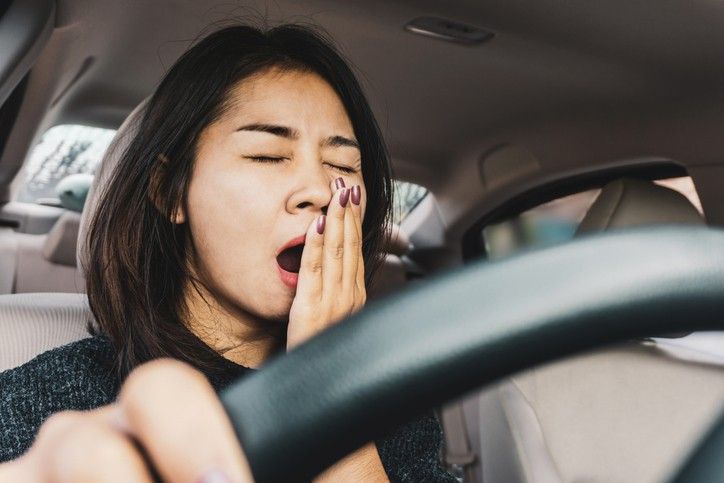Table of Contents
ToggleWe have all heard about the dangers of drunk driving. Countless campaigns and laws target this risky behavior. But what about driving while sleepy? Is drowsy driving just as dangerous as getting behind the wheel after a few drinks? At Altman Nussbaum Shunnarah, we believe it is crucial to shed light on this often-overlooked road safety issue.

The Hidden Danger on Our Roads
Imagine you are driving home after a long day at work. Your eyelids feel heavy, and you catch yourself yawning repeatedly. You might think, “I’m just a little tired. I can make it home.” But the truth is drowsy driving can be just as deadly as drunk driving.
Many people do not realize how much fatigue can impact their driving abilities. When you are sleepy, your reaction times slow down, your decision-making skills worsen, and your attention wavers. These effects mirror those of alcohol intoxication, making drowsy driving a serious threat to road safety.
The Shocking Statistics
The numbers paint a grim picture. According to the NHTSA, drowsy driving leads to around 100,000 crashes each year in the United States. These accidents result in roughly 1,550 deaths and 71,000 injuries annually. These figures are likely underestimated as it is often difficult to determine if fatigue played a role in a crash.
Compare this to drunk driving statistics: In 2022, alcohol-impaired driving fatalities accounted for 10,142 deaths. While this number is higher, it is important to note that drowsy driving incidents are harder to identify and report. The true toll of drowsy driving may be much higher than current data suggests.
The Science Behind Drowsy Driving
To further understand why drowsy driving is so dangerous, we need to look at how sleep deprivation affects the brain. When you are tired, your brain struggles to process information quickly and accurately. This slowing down of cognitive functions can have severe consequences when you are behind the wheel.
Research shows that being awake for 18 hours straight causes impairment equal to a blood alcohol concentration (BAC) of 0.05%. After 24 hours without sleep, your impairment is equivalent to a BAC of 0.10% – well above the legal limit in all states.
Besides, drowsy driving can lead to microsleeps – brief, involuntary episodes of sleep that can last for a few seconds. During a microsleep, a driver traveling at highway speeds can cover the length of a football field with their eyes closed. It is easy to see how this could lead to a catastrophic accident.
Who’s at Risk?
While anyone can fall victim to drowsy driving, certain groups are at higher risk:
- Shift workers and people with irregular work schedules
- Commercial drivers, especially those operating large vehicles or driving long distances
- People with untreated sleep disorders like sleep apnea
- Teenagers and young adults who often don’t get enough sleep
- Business travelers experiencing jet lag
It is crucial for individuals in these high-risk groups to be extra vigilant about their alertness when driving.
What Does the Law Say?
Unlike drunk driving, which can be measured through blood alcohol tests, there is no definitive way to test for drowsiness. This makes it challenging to enforce laws specifically targeting drowsy driving. However, most states have general reckless driving laws that can apply to fatigued drivers who cause accidents.
Some states have taken more direct action. For example, New Jersey enacted “Maggie’s Law” in 2003, which specifically defines driving while fatigued as recklessness under the state’s vehicular homicide statute. Under this law, a sleep-deprived driver who causes a fatal crash can face up to 10 years in prison and a $100,000 fine.
Prevention is Key
Given the dangers of drowsy driving and the difficulties in enforcing related laws, prevention becomes crucial. Here are some strategies to avoid drowsy driving:
- Get enough sleep: Adults need seven to nine hours of sleep per night. Make sleep a priority, especially before long drives.
- Recognize the signs: If you are yawning frequently, drifting from your lane, or having trouble focusing, it’s time to pull over.
- Take breaks: On long trips, stop every two hours or 100 miles to rest and stretch.
- Avoid driving during peak sleepiness periods: For most people, this is in the late afternoon and between midnight and 6 am.
- Use the buddy system: On long trips, take turns driving with a well-rested passenger.
- Do not rely on quick fixes: Coffee or energy drinks might provide a temporary boost, but they’re not substitutes for proper sleep.
Call a Massachusetts Personal Injury Lawyer Today
At Altman Nussbaum Shunnarah, we are committed to promoting road safety and helping those affected by accidents. If you or a loved one has been involved in an accident caused by a drowsy driver, don’t hesitate to reach out. Our team can help you understand what legal options you have.




